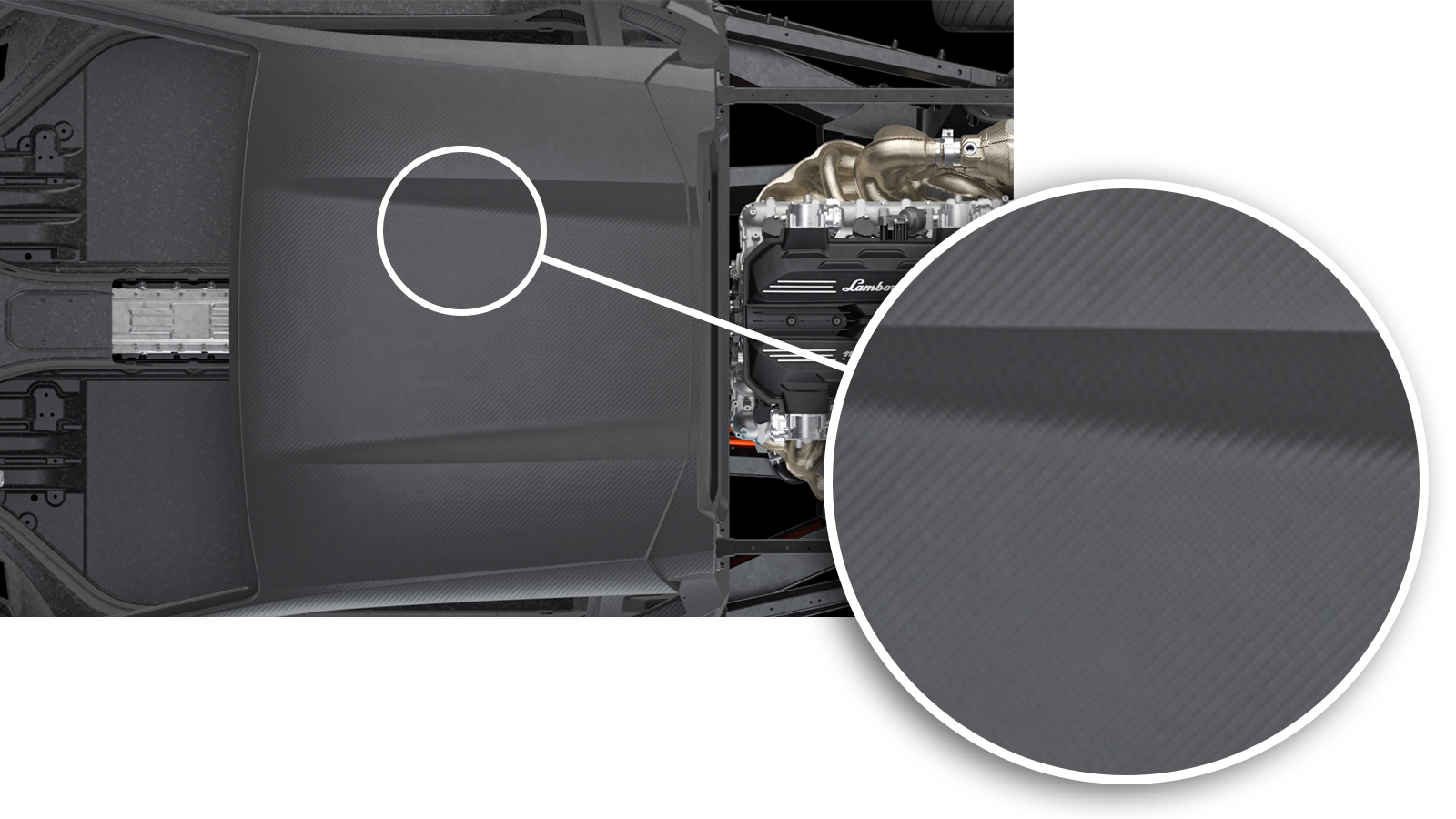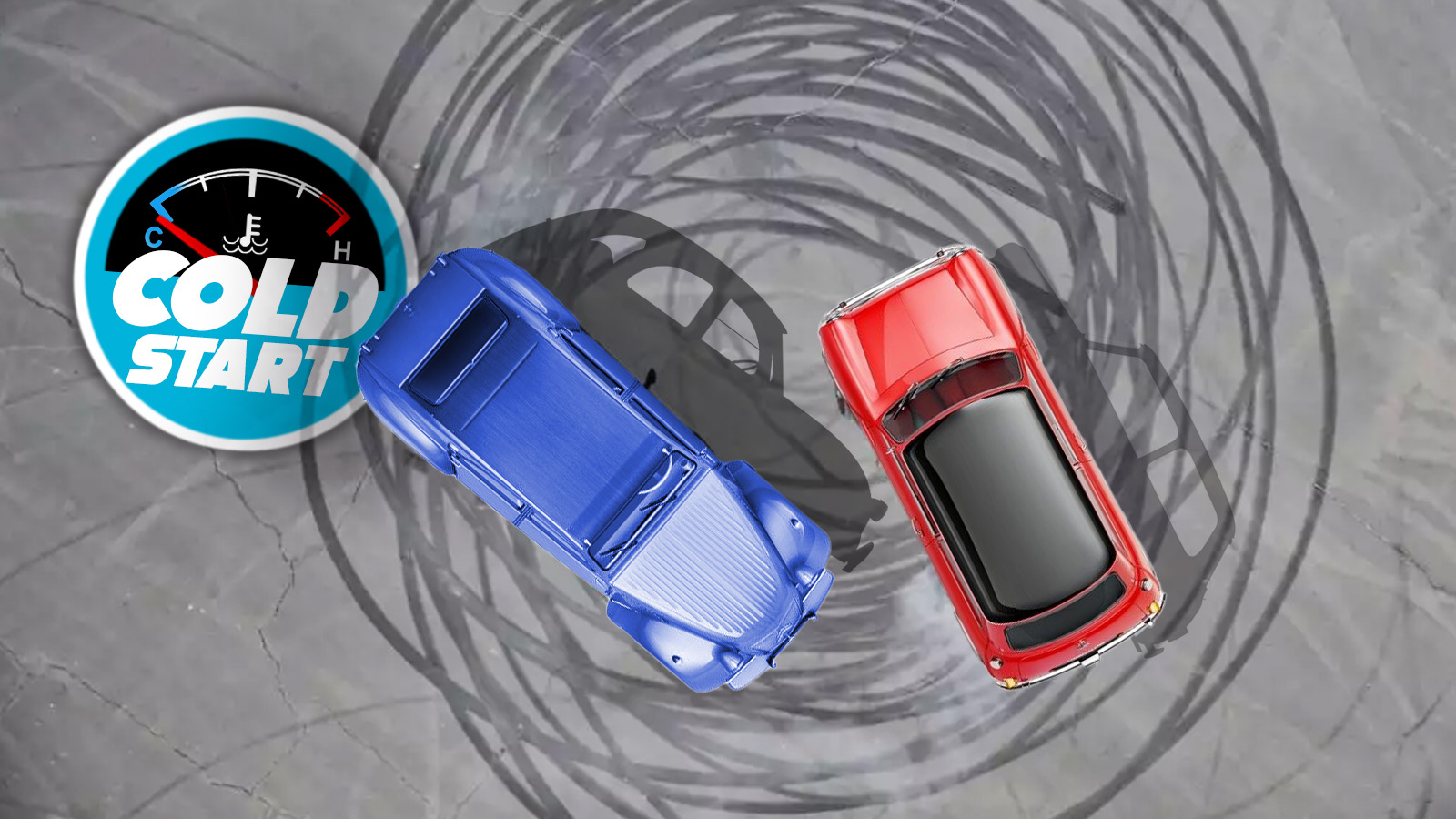As the clock ticks ever closer to the arrival of a new V12-powered flagship from St’Agata, Lamborghini has dropped some more details on the incoming Aventador replacement. This time, the company wants to highlight the new car’s structure, as it’s supposed to be lighter, stiffer, and more carbon fiber-intensive than what we’re used to.

In a move not seen on previous supercars, the entire front crash structure of the next big bull is made of forged carbon composites. Needless to say, this is a huge departure from the Aventador’s aluminum front crash structure. While the carbon fiber we’re more used to is woven into mats, forged carbon composites use a bunch of short individual carbon fibers that are immersed in resin and then put under pressure. Not only is this a low-waste process, it’s less labor-intensive than making parts out of woven carbon fiber. Plus, it’s claimed to be 20 percent lighter than the aluminum structure in the Aventador, a good thing when you have two electric motors between the front wheels.
What’s more, the front firewall, tub, and inner A-pillars are also made of forged carbon composites, strategically reinforcing an otherwise primarily woven carbon fiber passenger cell. Each side of the passenger cell is made from a single piece of carbon fiber reinforced plastic which offers great strength-to-weight. The roof is also pre-impregnated carbon fiber reinforced plastic, offering up a beautiful weave.

As for the rear structure of the Aventador replacement, it’s made of traditional aluminum alloys, but with a few new tricks including new castings that help provide improved rigidity. It’s also worth noting that the Aventador replacement ditches the outgoing car’s pushrod rear suspension in favor of a more traditional coil-over-strut arrangement. Rear-wheel-steering also appears to be present, while the rear anti-roll bar is slung over the upper structure rails.
Perhaps more telling than what’s here in Lamborghini’s press photos is what isn’t. The muffler, charge port mount, and cooling systems are all absent, but gaps in packaging let us speculate. There’s an awful lot of room behind the powertrain thanks to a new transverse gearbox, so I wouldn’t be surprised if the muffler system is on the larger side. In addition, it’s a safe assumption to expect heat exchangers ahead of the rear wheels, and the length of the charge port wiring suggest a charge port location on the vehicle’s front clip, possibly on the left front fender.

Lamborghini says that the Aventador replacement will be launched in just a few weeks, so we won’t have to wait long to learn a whole lot more about the new big bull. With 1,001 horsepower, plug-in hybrid punch, and many different forms of carbon composites in the structure, this high-tech flagship is shaping up to be punchier, stiffer, and greener than ever before.
(Photo credits: Lamborghini)
Support our mission of championing car culture by becoming an Official Autopian Member.

-
The Plug-In Hybrid Lamborghini Aventador Replacement Will Be A 1,001-Horsepower Declaration Of War
-
Here’s Why The Last All-Combustion V12 Lamborghinis Are Worth Remembering
-
Meet The Lamborghini Concept Car That Inspired A Bunch Of Chrysler Sedans In The 1990s
-
Here’s What Lamborghini Did To The Huracan Supercar To Turn It Into An ‘Off-Roader’ Called The Lamborghini Huracan Sterrato
-
How Lamborghini Completely Half-Assed The Lights On Its Most Legendary Supercar
Got a hot tip? Send it to us here. Or check out the stories on our homepage.







Like most i’m going to have a dig for them saying ‘forged’.It’s pressure cast.The end.
But i get they want to hype it up a bit.It’s not a big lie
Autoclaves are quite high pressure to be sure, but metallic forging still requires higher pressures. Your 10 bar autoclave is applying roughly 21 ksi of pressure, but the flow stresses needed for hot steel forging are on the order of 200-300 MPa/30-45 ksi. Cold forging will require substantially higher pressures, sometimes into the GPa range.
I would guess what Lambo actually means by “forged carbon” is less about the mechanical pressures involved and more along the lines of a composite analogue for the grain direction control that is also implied with a forging process. Instead of having to deal with a tedious hand layup followed by autoclave cure, they are using their process to apply pressures that will result in the laminate assuming the desired configuration as a result of the forming forces applied to it rather than having to ensure the proper configuration prior to applying heat and pressure. You get the same mechanical properties with a much cheaper production process.
Hexel has been using the process for a while now, quite a lot of their parts are appearing on commercial air and spacecraft.
“Cobbled” seems like a better descriptive word for an Italian supercar construction technique.
Shit you don’t need to buy a Lamborghini to get forged carbon fiber. You can put fake carbon fiber on anything!
https://www.youtube.com/watch?v=JiP2sMHwdUE
Just put some seats and a windshield on that and I would rock that thing! Ok, maybe add some cooling system stuff if its ABSOLUTELY needed…
How long before someone (maybe even Lamborghini themselves), remove the electric part to make a gas only screamer? and how much weight could they remove?
I thought the same as well, especially for the racing. I am sure Lamborghini has something special tucked away in the parts department. A special handshake to perform or specific phrase to utter is all one has to do to get the kit.
Case in point, some specialists figured a way to revert the 599 GTB and Porsche 911 GT3 to the manual gearboxes. When there’s a will, there’s a way.
I seem to recall Lamborghini laying a lot of this groundwork in the Sesto Elemento, but don’t remember how much of the chassis on that one was aluminum vs carbon fiber composite. (Very little, I think, but have no numbers.)
I’m a little surprised that it (Sesto Elemento) wasn’t mentioned in the article. Once the new car is released, the engineering comparisons are almost inevitable.
The Sesto Elemento had weight comparable to a Mazda Miata. I hated the way it looked, but for a Lamborghini, it was refreshingly light. It is a direction that Lamborghini has long ago needed to head toward. None of its 2-ton lardasses that take up the road footprint of midsized SUVs appeal to me in the least. The Sesto Elemento bucks that trend, and for that, it should be cherished.
The question is how much does this car weigh? All the weight saving techniques in the world don’t amount to much if it ends up weighing as much as an SUV. And Lamborghinis have traditionally been morbidly obese cars, at least after the original Miura, and they keep getting heavier and heavier.
I do like the Sesto Elemento for its low weight, but have never been a fan of the angular, drag-inducing wedge designs that this manufacturer has kept since Gandini’s Countach, and which have gotten ever more extreme since.
The Miura is my favorite Lamborghini. It just looks good and is generally a no-bullshit design(pun-intended).
Again I see really awesome measures that only seem to come out when moving into a crappy electric vehicle.
Make a gasoline version with that structure minus the added electric motor and battery weight. *THATS* what people wanted to see.
If electric doesn’t get special tricks gasoline engines don’t it simply can’t compete. When gas cars are steel frame and electric cars get fancy aluminum and carbon fiber frames it’s no longer apples to apples.
I have a 1500lb gasoline car made out of Aluminum and average 70-80 miles per gallon. If cars like this were made more often we wouldn’t be crying about the need to go electric.
Supposedly making cars out of Aluminum was just too hard (queue crybaby tone) but now that batteries weigh so much magically the whole industry can start using these nicer materials they wouldn’t give us with gas engines.
It’s almost like we can only have non-rusting frames if there is some kind of battery to make sure it still depreciates into the ground.
I’m quite sure that a 1500lbs aluminum car isn’t going to meet any kind of modern crash safety standards – that’s where most of the weight of modern ICE vehicles comes from. Making cars out of aluminum isn’t hard – making cars out of aluminum that *meet safety regulations* is.
The Mitsubishi Mirage, built of cheap, conventional materials, weighs in at 2,080 lbs. It helps that it doesn’t come fully-loaded from the factory with extraneous profit-adding features.
Or any desirability-adding features…
Build the car light and with a powerful engine from a reliable Japanese marque, and streamline it so that it also gets excellent economy and running costs, and also has sufficient power to weight ratio that it is able to perform like cars that cost 3-5x as much, and that by itself will be highly desirable.
But it will also cannibalize the sales of much more expensive and more profitable cars, which is why we don’t see such a thing available from the mainstream automakers. If you want a sports car, your choices are mostly overweight, feature-saturated, oversized, bloated things with correspondingly high price tags, whose costs tend to be expressed as geometric function of horsepower. It doesn’t have to be this way, except that bean counters and executives force it to be so in order to maximize the amount of money coming their way.
I mean, it also has an 813hp at 9250rpm V12 so it is a gasoline version.
Just waiting for the tech to get cheap enough for regular cars….but not holding my breath.
I enjoy these super cars, but I don’t know where people get full use out of these things. I guess the status symbol of them might be useful in other ways Im not considering as well.
I forsee the metal industry suing them for misuse of the word “forged”.
verb
past tense: forged; past participle: forged
make or shape (a metal object) by heating it in a fire or furnace and beating or hammering it.
It’s “forged” because it’s fake.
Yeah… It’s a rigid molded carbon composite. The technology has been around for decades now, although new formulations and processes keep coming along that make it better and better. It’s even become popular in filament forms for using in 3D printing. Just an interesting use of the material technology in automotive engineering, and it probably is advancing the state of the art. But “forged”? I don’t really think that’s the right word, Lamborghini…
Maybe they’re reaching for ‘cold forged?’
‘Squished-into-shape’ doesn’t have the same ring to it, though.
It seems like the right term here should be “felted.”
Was thinking the same thing. It sounds more like molded carbon fiber, or possibly even injection molded.
I think the difference between this and regular molding is the application of pressure, making it somewhat analogous to metal forging.
Pretty car but I think it would be easier for me to fit in a pair of skinny jeans than to fit in this thing.
Not sure how roomy this will be but an acquaintance had a Huracan and it wasn’t too tight inside. Just a low roof.